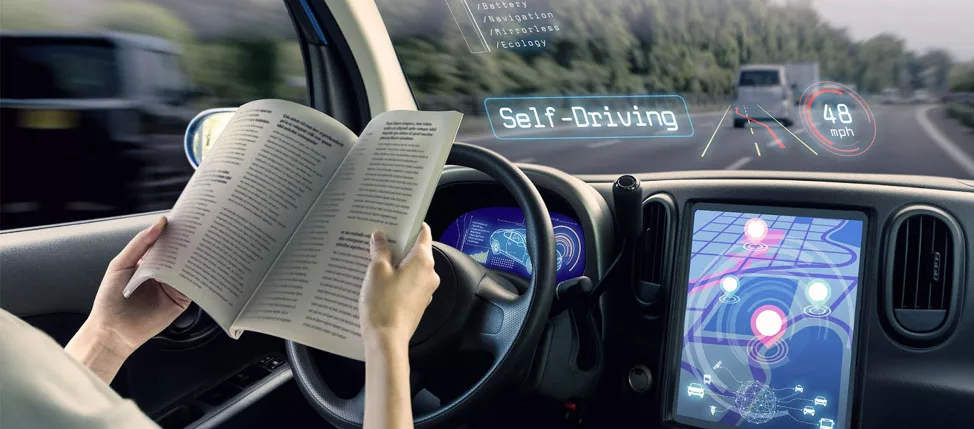By The Pollack Group
By Faith DeLucia, The Pollack Group Summer Intern
The thought of self-driving cars is becoming increasingly attractive to consumers around the world.
It can be like taking a taxi to work without the awkward silence between you and your driver on the commute, while reading the New York Times daily newsletter AND watching your favorite show on Hulu. By theoretically allowing for more personal leisure time, creating safer streets, and optimizing fuel consumption, introducing the autonomous car could improve our lives tremendously.
Fifty years ago, American computer scientist John McCarthy teased the world with the initial idea of a driverless car. In his essay “Computer-Controlled Cars,” McCarthy referred to this invention as an “automatic chauffeur,” a car equipped with a television camera that displays the same visual abilities as a human driver.
Tesla, Volvo, and BMW began to make the dream of the self-automated vehicle come true by creating self-assisted parking technology. Google took it one step further and developed the first self-driving car, “Waymo,” which has successfully driven two million miles without an accident.
So, why aren’t the roads flooded with autonomous cars, and how is the Level 0 car market still skyrocketing?

The simple fact: Americans don’t trust the technology. Tesla’s Autopilot mode, which still involves the driver, has received flak for accidents. The already wavering approval ratings of the impending development severely plummeted after Uber’s driverless vehicle-testing on public Arizona roads caused a fatality.
Despite setbacks, the technology still has tantalizing potential. Let’s look at the pros and cons of these driverless machines:
PROS
1. Improving traffic conditions
The average U.S. commuter spends around 42 hours in traffic per year and loses $1,400 idling away gas. The development of vehicle platooning, or the ability of vehicles to travel closely and safely together at high speeds in response to a lead vehicle’s movement, could exponentially decrease traffic while increasing the capacity of roads and providing a more steady flow of traffic.
2. Reduced Carbon Footprint
Vehicles built to optimize efficiency in acceleration, braking and speed variation could reduce CO2 emissions by 300 million tons per year.
3. Significant Reduction In U.S. Car Crashes And Deaths
Of the 37,000 car crash-related fatalities that occur in America each year, 94 percent are due to human error. With the use of radar sensors, cameras, and lidar units, autonomous vehicles are able to drive on local roads while tracking their surroundings and registering where they are in the world. This advanced technology is estimated to reduce automobile-related fatalities by up to 90 percent. While the risks of driverless cars are still top of mind, autonomous vehicles can ultimately have a positive effect on road safety.
4. Gaining Productivity
The average commute time for Americans is 25 minutes, and research shows that 60% of drivers feel stressed during peak driving times. With a car that does not need a driver to function, people could feel far more at ease and could utilize that time by accomplishing other tasks such as connecting with old friends, learning a new language, reading books, or getting ahead of deadlines.
While public transportation may offer similar benefits of autonomous cars, such as additional leisure in place of driving time, the driverless car provides a sense of privacy and customized comfort that public transportation will rarely deliver.
CONS
1. Vehicle Safety And Cybersecurity
Although autonomous vehicle technologies are becoming increasingly more intelligent and reliable, there is always a chance of glitches in the system. Uber was the first company to dabble in creating a self-driving vehicle solely focused on transportation. While Uber spent years solidifying the advancements and precision of the technology, the autonomous transportation vehicle’s March fatality occurred when it flagged the detection of a passing-by pedestrian as a “false positive.”
This fatal incident resulted in Uber halting its self-driving car operations in all cities it had been testing its vehicles. A study conducted shortly after the accident found that 73 percent of Americans would be afraid to ride in an autonomous vehicle. While they find success in overcoming the technological bumps in the road, autonomous vehicle-makers are now stumbling over the psychological ones.
In addition to expending all efforts to eliminate any faulty judgments, these vehicles will have to defend themselves against cyberattacks and system hacks.
2. Impact On Driving Jobs
Autonomous vehicles might make trips shorter and create more leisure time for riders, but they will significantly decrease jobs for taxi and rideshare drivers. Nearly 4 million jobs could be lost.
3. Cost
Though these cars are not on the market just yet, their extremely high prices will make the vision of fully autonomous car-filled roads virtually unobtainable for the average American. These vehicles are estimated to cost over $300,000 after all the necessary technologies required, initially rendering them a luxury rather than a significant slice of the marketplace.
4. The Joy Of Driving
A lot of people find pleasure in going for a drive after a long day. If automotive vehicles ultimately become banned and driverless cars overtake the automobile market, the joyride pastime will no longer be available.
The choice of representing individuality or style through owning a specific type of vehicle will also be eliminated.
—
Will automotive vehicles eventually become outlawed? How will automakers survive the ever-evolving era of self-driving vehicles? Forbes predicts that in 2030, one-in-four vehicles on the road will be self-driving.
Traditional automakers will have to reshape their business models by pairing with ride-sharing companies or by creating their own autonomous vehicles and marketing them at a more affordable price. In order for automakers to remain relevant through the increasing developments of driverless vehicles, they will need to adapt to shifting consumer needs as best as possible in today’s digitally-focused society.






